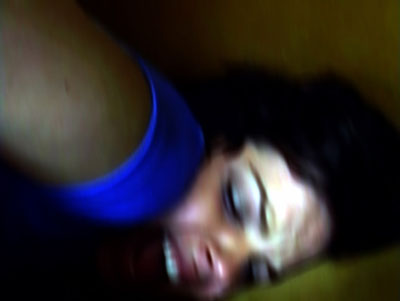 Untitled, 2004 Digital Print, 40 x 50 cm António Nuno Júnior Voyeur has been defined as someone who obtains sexual gratification from looking at sexual organs or sexual acts performed by others, and also as someone who enjoys observing other people's private lives without their knowledge. Voyeur has had a negative meaning as it has been understood as implying an intentionally wrong act. According to Marcel Proust voyeurism can be performed by the lover looking through the window at his beloved. Nowadays, this image looks too idealistic. It belongs to another world somewhere in the past. Voyeur understood as an act of seeing/looking/observing in the general sense has become a hobby in present day Western world - one can observe not only one's own daily life as well as, through the media, see images of others miserable lives. To observe is safer than to adventure in the inherent dangers of present day world. As such, to exist entails to be a voyeur, by the impossibility/difficulty of being anything else, and, therefore, to live through a visual culture saturated by publicity, wars, politics, pornography, ... where frontiers merge and have become obsolete. We see constantly images/scenes that ironically reflect our own factuality and freedom. We are not aware of our own positioning because we ourselves are nothing. According to Sartre, "...since I am what I am not and I am not what I am - I cannot define myself as truly being in the act... of voyeurism. Not only I cannot know myself, as also my own self eludes me - even though I am myself this eluding is my own being - and I am absolutely nothing." But then who detains the power? The one that looks or the one that has what the other desires? The object of desire? The History of Art abounds in erotic works by great masters. They are images captured by the artist - himself taking the role of a voyeur. The last and famous work by Marcel Duchamp entitled "Etant Donnés" is a good example. It has been exhibited at the Philadelphia Museum of Art since 1969 (after the artist's death). This piece of work is satirical, a peep show, that challenges the viewer to abandon his point of view as a passive observer and become aware of his position as a voyeur of a work of explicit sexuality. Duchamp "rapes" the female body by using it in a metaphorically. In a certain way, the abandoned woman of "Etant Donnés" is Duchamp himself, possibly Rose Sélavy. The work "Etant Donnés" turns the museum into a place of pleasure, a space of voyeurism, where works of art can be observed and where one can be marvelled, but, nevertheless, one cannot touch. In the sixties, the art gallery as a space was the object of several interventions. The Rosario Group, taking to and extreme the questioning art and its placement presented an empty gallery where the door only open inwardly, and closing the space hermetically from the inside. At the opening, the public after some time realized that they were locked inside the gallery and had become the actual artwork. They had to break the gallery window in order to get out. There are many references in art history to inspire today's artists, photographers, and filmmakers. The aims of this project is to show uncanny rare and memorable works by contemporary artists on the subject of voyeurism. The selection of different generations of Portuguese and foreign artists examines the relationship between the voyeur and his object of desire through different mediums. This project is organized by the artist. Curator: Rodrigo Vilhena Exhibition: May 12 - June 12, 2005 Opening hours: open 24 hours a day Voyeur Project View Rua de Timor, Nº 14-A, ANJOS P-1170-372 Lisboa Telephone +351 961 825 575 Email info@voyeurprojectview.org www.voyeurprojectview.org The Voyeur Project View space is an alternative gallery located in the Anjos quarter, in Lisbon, Portugal. Solo exhibitions are shown to the public through a peephole in the door that can be accessed 24 hours a day. Admittance to the gallery is by appointment. |